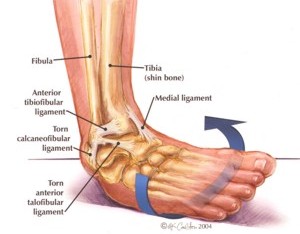I bet there are very few people that have not sprained their ankle at some point or another. It is one of the most common injuries whether through sport or not. What is surprising is that the way most people treat their injury is less than ideal and often leaves a deficiency leading to recurrent injuries in the future. I have lost count how many people have told me they have a weak ankle as a result of a previous injury.
Lets look at what actually happens when you sprain your ankle. The term ankle sprain’ refers to an injury to one or more of the ligaments around the ankle joint. Ligaments are thickened tissue that connects 2 bones to hold the joint together and provide support. Most commonly a few fibres within the ligament are torn but in severe cases the whole ligament can be completely ruptured.
An injury to a ligaments usually occurs when they are overstretched rapidly beyond their normal length. This is most commonly done during an inversion injury (rolling the ankle inwards) overstretching and injuring the ligaments on the outside of the ankle. A similar injury can occur on the inside of the ankle when the ankle twists outwards but this is much less common. The severity of the sprain is graded as follows.

Grade I: mild stretching of the ligament
Grade II: Partial rupture of the ligament
Grade III: Full rupture of the ligament resulting in instability of the ankle
Generally most people are aware of the point when the ligaments were injured. The ankle may be painful to walk on and swell very quickly but swelling can also develop over a few hours. For severe sprains the ankle may bruise. Movements of the ankle are also painful.
If there is tenderness on the bones of the ankle or foot and you are struggling to bear weight it is advisable to visit the local emergency department for an assessment and possible xray to check for any fractures (breaks to the bone). Generally damaged ligaments heal themselves within 2-6 weeks depending on severity.
As mentioned earlier, there are a number of common mistakes that people tend to make when recovering from this type of injury.
– Resting too much can lead to poor quality and reduced loading ability of healing tissue as well as taking longer to heal.
– Being too active in the early stages thus disrupting the healing process.
– Not fully strengthening the ankle once the pain has subsided.
– Failing to improve the proprioceptive function to the ankle. This is basically the speed at which receptors in your tissues pick up changes in joint position and relay that to the brain so that a reaction can be triggered in the muscles to re-correct the position. This is essential in preventing future re-occurences.
So, what should you do
It is important to rest the ankle for a few days to allow healing to begin. Bearing weight on it is helpful however you may require crutches initially in order to do this. A compression bandage can be useful in limiting the amount of swelling and regular ice packs can help with pain relief. Elevating the limb regularly for those first few days will also help reduce the swelling.
You can gently move the ankle up and down several times a day during the first few days to improve the movement of the joint. After a week you can start to turn the ankle in and out.
Inflammation is generally considered an unwanted symptoms of a ligament injury but this is your body’s natural healing process. Whilst anti inflammatory medication is commonly used to ease the pain it is not advisable to take these for the first few days after your injury as it impairs that healing process.
Once the pain has subsided you should start strengthening the muscles of the ankle and lower leg as well as re-training your proprioception. Simple exercises such as calf raises and balancing on 1 leg. If you want to return to sport ensure the ankle is pain free and no longer swollen
How can physiotherapy help you?
A physiotherapy programme will result in faster recovery times, early return to training or other activities and prevent future re-occurences. In the early stages a qualified Physiotherapist will be able to help you manage the swelling, reduce the pain and regain motion in the ankle. This will likely involve specific exercises, soft tissue massage, ultrasound and taping.
Once the pain has settled and movement regained they can take you through a structured and progressive strengthening and proprioceptive programme. They can often give you advice to allow you to return to training earlier than normal, all be it with a few restrictions initially.
As with any injury, if in doubt get it checked out.

